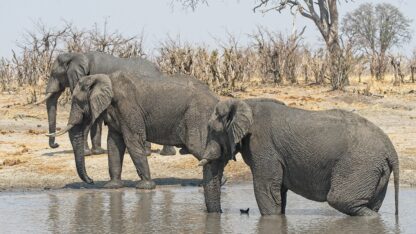It’s not often you find a bright side to drought, but in Texas, the heat and lack of rain have uncovered dinosaur tracks from 113 million years ago.
The tracks were unveiled at Dinosaur Valley State Park in Glen Rose, Texas — about an hour’s drive from Fort Worth. The park is known for its dinosaur tracks, but these newer ones are usually covered with water from the Paluxy River and aren’t visible.
“Due to the excessive drought conditions this past summer, the river dried up completely in most locations, allowing for more tracks to be uncovered here in the park,” the Texas Parks and Wildlife Department said in a statement. “Under normal river conditions, these newer tracks are under water and are commonly filled in with sediment, making them buried and not as visible.”
Dinosaur tracks are not as rare as, say, dinosaur bones, according to professor Jerry Harris, the director of paleontology at Utah Tech University, but that’s because dinosaurs left way more footprints throughout their lives and ultimately had only one skeleton to leave behind.
Dinosaur tracks reveal more about how the reptiles lived
Still, Harris said the newly exposed tracks present a valuable find for researchers because they were made by living animals and can tell those studying the fossils more about the dinosaurs’ behavior and day-to-day lives.
“You can get a lot of information about the posture of the animal that would be more difficult to get from the skeleton, about the speed, the animal which was moving, how it was responding to the sediment when the sediment was loose before it was turned to rock,” Harris said.
It’s also possible to determine whether the dinosaur was moving in a certain direction, why it was going that way or whether multiple dinosaurs were moving together in a herd, Harris said, adding that all this is much more difficult to discern from studying skeletons alone.
As for the dinosaur that left the newly uncovered tracks, the Texas Parks and Wildlife Department said they belong to a theropod called Acrocanthosaurus — one of the two dinosaurs that make up the majority of tracks found around the state park.
“This was a dinosaur that would stand, as an adult, about 15 feet tall and [weigh] close to seven tons,” the Texas Parks and Wildlife Department said.
Water will cover the tracks again
Eventually, water will cover the tracks again, and they’ll be filled with sediment that helps prevent them from eroding away. But before that happens, researchers are working on mapping the tracks and collecting data.
While the discovery of the tracks is exciting, it also presents an interesting juxtaposition, Harris said.
“There’s some irony in the fact that dinosaurs, which were ultimately wiped out by very rapid climate change, now [the] evidence of their living animals was exposed because of human-made climate change today.”
Copyright 2022 NPR. To see more, visit https://www.npr.org.
9(MDAxODM0MDY4MDEyMTY4NDA3MzI3YjkzMw004))

9(MDAxODM0MDY4MDEyMTY4NDA3MzI3YjkzMw004))









